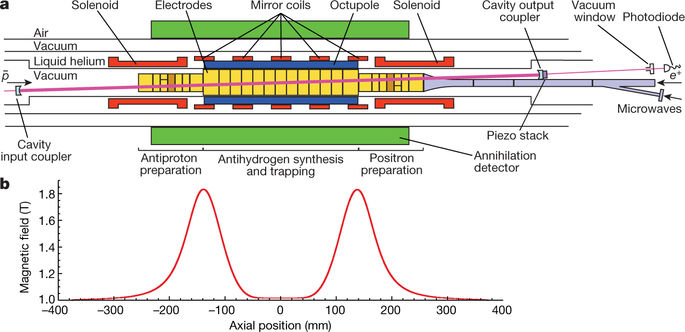Our official English website, www.x-mol.net, welcomes your feedback! (Note: you will need to create a separate account there.)
Characterization of the 1S–2S transition in antihydrogen
Nature ( IF 64.8 ) Pub Date : 2018-04-04 , DOI: 10.1038/s41586-018-0017-2 M Ahmadi 1 , B X R Alves 2 , C J Baker 3 , W Bertsche 4, 5 , A Capra 6 , C Carruth 7 , C L Cesar 8 , M Charlton 3 , S Cohen 9 , R Collister 6 , S Eriksson 3 , A Evans 10 , N Evetts 11 , J Fajans 7 , T Friesen 2 , M C Fujiwara 6 , D R Gill 6 , J S Hangst 2 , W N Hardy 11 , M E Hayden 12 , C A Isaac 3 , M A Johnson 4, 5 , J M Jones 3 , S A Jones 2, 3 , S Jonsell 13 , A Khramov 6 , P Knapp 3 , L Kurchaninov 6 , N Madsen 3 , D Maxwell 3 , J T K McKenna 6 , S Menary 14 , T Momose 11 , J J Munich 12 , K Olchanski 6 , A Olin 6, 15 , P Pusa 1 , C Ø Rasmussen 2 , F Robicheaux 16 , R L Sacramento 8 , M Sameed 3, 4 , E Sarid 17 , D M Silveira 8 , G Stutter 2 , C So 10 , T D Tharp 18 , R I Thompson 10 , D P van der Werf 3, 19 , J S Wurtele 7
Nature ( IF 64.8 ) Pub Date : 2018-04-04 , DOI: 10.1038/s41586-018-0017-2 M Ahmadi 1 , B X R Alves 2 , C J Baker 3 , W Bertsche 4, 5 , A Capra 6 , C Carruth 7 , C L Cesar 8 , M Charlton 3 , S Cohen 9 , R Collister 6 , S Eriksson 3 , A Evans 10 , N Evetts 11 , J Fajans 7 , T Friesen 2 , M C Fujiwara 6 , D R Gill 6 , J S Hangst 2 , W N Hardy 11 , M E Hayden 12 , C A Isaac 3 , M A Johnson 4, 5 , J M Jones 3 , S A Jones 2, 3 , S Jonsell 13 , A Khramov 6 , P Knapp 3 , L Kurchaninov 6 , N Madsen 3 , D Maxwell 3 , J T K McKenna 6 , S Menary 14 , T Momose 11 , J J Munich 12 , K Olchanski 6 , A Olin 6, 15 , P Pusa 1 , C Ø Rasmussen 2 , F Robicheaux 16 , R L Sacramento 8 , M Sameed 3, 4 , E Sarid 17 , D M Silveira 8 , G Stutter 2 , C So 10 , T D Tharp 18 , R I Thompson 10 , D P van der Werf 3, 19 , J S Wurtele 7
Affiliation

|
In 1928, Dirac published an equation1 that combined quantum mechanics and special relativity. Negative-energy solutions to this equation, rather than being unphysical as initially thought, represented a class of hitherto unobserved and unimagined particles—antimatter. The existence of particles of antimatter was confirmed with the discovery of the positron2 (or anti-electron) by Anderson in 1932, but it is still unknown why matter, rather than antimatter, survived after the Big Bang. As a result, experimental studies of antimatter3–7, including tests of fundamental symmetries such as charge–parity and charge–parity–time, and searches for evidence of primordial antimatter, such as antihelium nuclei, have high priority in contemporary physics research. The fundamental role of the hydrogen atom in the evolution of the Universe and in the historical development of our understanding of quantum physics makes its antimatter counterpart—the antihydrogen atom—of particular interest. Current standard-model physics requires that hydrogen and antihydrogen have the same energy levels and spectral lines. The laser-driven 1S–2S transition was recently observed8 in antihydrogen. Here we characterize one of the hyperfine components of this transition using magnetically trapped atoms of antihydrogen and compare it to model calculations for hydrogen in our apparatus. We find that the shape of the spectral line agrees very well with that expected for hydrogen and that the resonance frequency agrees with that in hydrogen to about 5 kilohertz out of 2.5 × 1015 hertz. This is consistent with charge–parity–time invariance at a relative precision of 2 × 10−12—two orders of magnitude more precise than the previous determination8—corresponding to an absolute energy sensitivity of 2 × 10−20 GeV.The shape of the spectral line and the resonance frequency of the 1S–2S transition in antihydrogen agree very well with those of hydrogen.
中文翻译:

反氢中 1S-2S 转变的表征
1928年,狄拉克发表了一个结合了量子力学和狭义相对论的方程1。这个方程的负能量解并不像最初认为的那样是非物理的,而是代表了一类迄今为止未被观察到和想象不到的粒子——反物质。1932年,安德森发现正电子2(或反电子),证实了反物质粒子的存在,但目前仍不清楚为什么物质而不是反物质在大爆炸后幸存下来。因此,反物质的实验研究3-7,包括电荷宇称和电荷宇称时间等基本对称性的测试,以及寻找原始反物质(如反氦核)的证据,在当代物理学研究中具有高度优先地位。氢原子在宇宙演化和我们对量子物理学理解的历史发展中的基本作用使得它的反物质对应物——反氢原子——受到特别关注。当前的标准模型物理学要求氢和反氢具有相同的能级和谱线。最近在反氢中观察到激光驱动的 1S-2S 转变。在这里,我们使用反氢的磁捕获原子来表征这一转变的超精细成分之一,并将其与我们装置中氢的模型计算进行比较。我们发现谱线的形状与氢的预期非常吻合,并且共振频率与氢的共振频率一致,在 2.5 × 1015 赫兹中大约有 5 千赫兹。这与相对精度为 2 × 10−12 的电荷宇称时间不变性一致——比之前的测定精确两个数量级8——对应于 2 × 10−20 GeV 的绝对能量灵敏度。反氢中1S-2S跃迁的谱线和共振频率与氢的谱线和共振频率非常一致。
更新日期:2018-04-04
中文翻译:

反氢中 1S-2S 转变的表征
1928年,狄拉克发表了一个结合了量子力学和狭义相对论的方程1。这个方程的负能量解并不像最初认为的那样是非物理的,而是代表了一类迄今为止未被观察到和想象不到的粒子——反物质。1932年,安德森发现正电子2(或反电子),证实了反物质粒子的存在,但目前仍不清楚为什么物质而不是反物质在大爆炸后幸存下来。因此,反物质的实验研究3-7,包括电荷宇称和电荷宇称时间等基本对称性的测试,以及寻找原始反物质(如反氦核)的证据,在当代物理学研究中具有高度优先地位。氢原子在宇宙演化和我们对量子物理学理解的历史发展中的基本作用使得它的反物质对应物——反氢原子——受到特别关注。当前的标准模型物理学要求氢和反氢具有相同的能级和谱线。最近在反氢中观察到激光驱动的 1S-2S 转变。在这里,我们使用反氢的磁捕获原子来表征这一转变的超精细成分之一,并将其与我们装置中氢的模型计算进行比较。我们发现谱线的形状与氢的预期非常吻合,并且共振频率与氢的共振频率一致,在 2.5 × 1015 赫兹中大约有 5 千赫兹。这与相对精度为 2 × 10−12 的电荷宇称时间不变性一致——比之前的测定精确两个数量级8——对应于 2 × 10−20 GeV 的绝对能量灵敏度。反氢中1S-2S跃迁的谱线和共振频率与氢的谱线和共振频率非常一致。



























 京公网安备 11010802027423号
京公网安备 11010802027423号